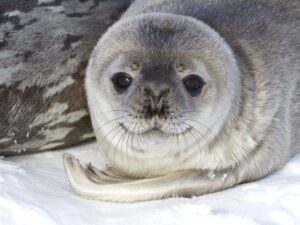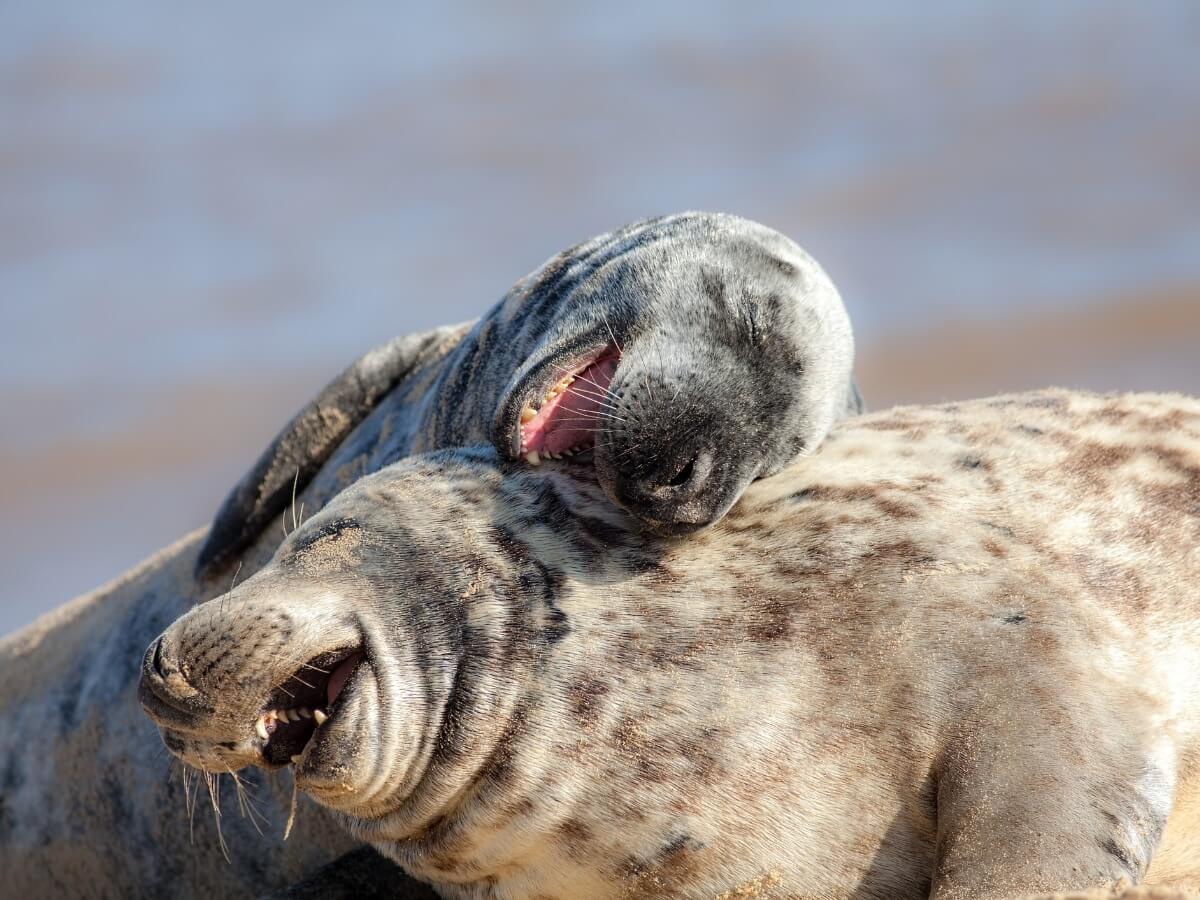9 Curiosities About Seals


Written and verified by the biologist Cesar Paul Gonzalez Gonzalez
Seals are one of the most charismatic marine mammal species we could find. In fact, this characteristic has been widely used to attract the attention of people in zoos. They naturally live in polar regions, but some specimens are even able to live near the tropics. Stay with us and find out some wonderful curiosities about seals.
Phocids, also known as true seals, belong to the pinniped group, which includes other famous mammals such as sea lions. Although these animals’ bodies don’t appear to hide anything, there are certain characteristics that many people don’t know. Continue reading to discover nine curiosities about seals.
What are seals like?
Seals have an elongated and cylindrical body with 4 limbs in the form of flippers. However, while the 2 forelimbs are separate (one on each side of the body), the 2 hind limbs are fused into a tail. This situation causes them to be unable to walk, so they crawl on the ground to move around.
The seal’s body is completely hydrodynamic, and it aids the correct flow of water. For this reason, their ears have no pinnae, so they look like small holes in their skin. This feature is unique within the group and is what differentiates them from their closest relatives, the sea lions.

Curiosities about seals
Anyway, now to the main point of today’s article! Let’s get to know some fascinating curiosities about seals that you may have never heard about.
1. Their fat provides protection
The typical fatness of seals is actually a defense mechanism to withstand the cold of their habitat. Contrary to what one might think, the fat they accumulate forms a kind of thermal insulation that separates all their internal organs from the ambient temperature. Thanks to this, they can submerge themselves in freezing waters without any metabolic consequences.
2. There are 19 different species of seals
True seals or earless seals belong to the family Phocidae, which contains about 19 different species. In fact, they’re the largest group within the order Pinnipedia (35 species in total), which includes sea lions and walruses.
3. They use their whiskers to detect water movement
As with other terrestrial mammals, the vibrissae (whiskers) of seals are a type of hair that has a great sensitive capacity. However, they don’t use them to directly touch their environment, but to sense fluctuations in the flow of water. In this way, they can identify the presence of their prey and even find their way around.
4. Their ancestors were land animals
According to scientists, life on planet Earth had its origin in water, so most aquatic animals come from ancestors that lived their entire lives in water. Despite this, marine mammals, such as seals, come from a special lineage that decided to return to the water after living for a long time as terrestrial beings.
5. Seals need to reproduce out of the water
Because they come from terrestrial ancestors, seals maintain the need to go out on land to reproduce. This is clear evidence of the evolutionary process they underwent and the origin of their lineage. Moreover, it’s for this very reason that they still maintain their lungs and haven’t been able to acquire “gills” for their aquatic life.

6. They’re able to last two hours without coming up to breathe
One of the most important adaptations that seals have is their ability to make efficient use of oxygen. Thanks to this, they’re able to dive for more than two hours without suffering hypoxia or any detrimental effect on their health. In fact, some seals even “sleep” underwater without any problems.
7. Some specimens dive to depths of more than 1.5 kilometers
One of the biggest problems divers have when diving to great depths is the water pressure. This situation causes damage to the circulatory system, which could lead to death if they aren’t careful. However, seals are able to evade this problem with great ease, as their circulatory system is adapted to withstand the pressure.
8. Some species feed on penguins
Elephant seals also often hunt penguins for food, as they contain a large amount of fat that’s very beneficial for them. Although it may seem strange, these huge animals are also part of the true seal group.
9. Seals don’t chew their food
To make their hunt more efficient, seals swallow their food or cut it into small pieces that they can devour in one sitting. They do this not because they don’t have teeth, but because it helps them to eat faster so that they have a chance to hunt other prey.
It’s normal to think that animals like seals don’t have any particularly interesting characteristics. However, sometimes nature bestows the most incredible abilities on species that attract the least attention. This shows that science is continually discovering new curiosities about animals that we couldn’t have ever imagined.
We hope you’ve enjoyed today’s article. We’ve chosen another fascinating article for you all about the elephant seal which we’ve mentioned in this article.
Seals are one of the most charismatic marine mammal species we could find. In fact, this characteristic has been widely used to attract the attention of people in zoos. They naturally live in polar regions, but some specimens are even able to live near the tropics. Stay with us and find out some wonderful curiosities about seals.
Phocids, also known as true seals, belong to the pinniped group, which includes other famous mammals such as sea lions. Although these animals’ bodies don’t appear to hide anything, there are certain characteristics that many people don’t know. Continue reading to discover nine curiosities about seals.
What are seals like?
Seals have an elongated and cylindrical body with 4 limbs in the form of flippers. However, while the 2 forelimbs are separate (one on each side of the body), the 2 hind limbs are fused into a tail. This situation causes them to be unable to walk, so they crawl on the ground to move around.
The seal’s body is completely hydrodynamic, and it aids the correct flow of water. For this reason, their ears have no pinnae, so they look like small holes in their skin. This feature is unique within the group and is what differentiates them from their closest relatives, the sea lions.

Curiosities about seals
Anyway, now to the main point of today’s article! Let’s get to know some fascinating curiosities about seals that you may have never heard about.
1. Their fat provides protection
The typical fatness of seals is actually a defense mechanism to withstand the cold of their habitat. Contrary to what one might think, the fat they accumulate forms a kind of thermal insulation that separates all their internal organs from the ambient temperature. Thanks to this, they can submerge themselves in freezing waters without any metabolic consequences.
2. There are 19 different species of seals
True seals or earless seals belong to the family Phocidae, which contains about 19 different species. In fact, they’re the largest group within the order Pinnipedia (35 species in total), which includes sea lions and walruses.
3. They use their whiskers to detect water movement
As with other terrestrial mammals, the vibrissae (whiskers) of seals are a type of hair that has a great sensitive capacity. However, they don’t use them to directly touch their environment, but to sense fluctuations in the flow of water. In this way, they can identify the presence of their prey and even find their way around.
4. Their ancestors were land animals
According to scientists, life on planet Earth had its origin in water, so most aquatic animals come from ancestors that lived their entire lives in water. Despite this, marine mammals, such as seals, come from a special lineage that decided to return to the water after living for a long time as terrestrial beings.
5. Seals need to reproduce out of the water
Because they come from terrestrial ancestors, seals maintain the need to go out on land to reproduce. This is clear evidence of the evolutionary process they underwent and the origin of their lineage. Moreover, it’s for this very reason that they still maintain their lungs and haven’t been able to acquire “gills” for their aquatic life.

6. They’re able to last two hours without coming up to breathe
One of the most important adaptations that seals have is their ability to make efficient use of oxygen. Thanks to this, they’re able to dive for more than two hours without suffering hypoxia or any detrimental effect on their health. In fact, some seals even “sleep” underwater without any problems.
7. Some specimens dive to depths of more than 1.5 kilometers
One of the biggest problems divers have when diving to great depths is the water pressure. This situation causes damage to the circulatory system, which could lead to death if they aren’t careful. However, seals are able to evade this problem with great ease, as their circulatory system is adapted to withstand the pressure.
8. Some species feed on penguins
Elephant seals also often hunt penguins for food, as they contain a large amount of fat that’s very beneficial for them. Although it may seem strange, these huge animals are also part of the true seal group.
9. Seals don’t chew their food
To make their hunt more efficient, seals swallow their food or cut it into small pieces that they can devour in one sitting. They do this not because they don’t have teeth, but because it helps them to eat faster so that they have a chance to hunt other prey.
It’s normal to think that animals like seals don’t have any particularly interesting characteristics. However, sometimes nature bestows the most incredible abilities on species that attract the least attention. This shows that science is continually discovering new curiosities about animals that we couldn’t have ever imagined.
We hope you’ve enjoyed today’s article. We’ve chosen another fascinating article for you all about the elephant seal which we’ve mentioned in this article.
All cited sources were thoroughly reviewed by our team to ensure their quality, reliability, currency, and validity. The bibliography of this article was considered reliable and of academic or scientific accuracy.
- Hanke, W., Witte, M., Miersch, L., Brede, M., Oeffner, J., Michael, M., … & Dehnhardt, G. (2010). Harbor seal vibrissa morphology suppresses vortex-induced vibrations. Journal of Experimental Biology, 213(15), 2665-2672.
- Thornton, S. J., & Hochachka, P. W. (2004). Oxygen and the diving seal. Undersea Hyperb Med, 31(1), 81-95.
- Jefferson, T. A., Webber, M. A., & Pitman, R. (2011). Marine mammals of the world: a comprehensive guide to their identification. Elsevier.
- Daniel Jr, J. C. (1981). Delayed implantation in the northern fur seal (Callorhinus ursinus) and other pinnipeds. Journal of reproduction and fertility. Supplement, 29, 35-50.
This text is provided for informational purposes only and does not replace consultation with a professional. If in doubt, consult your specialist.








